Microservices have remained a popular topic in software development: a way to create applications of independent services. This guide will delve into microservices, what microservices are in software (for context), benefits and challenges, and some of the best practices.
What are Microservices?
What are microservices? Let’s break down the word: “micro” (extremely small) + service. A microservice is a small, lightweight, and isolated service that works independently to perform a single function within an application. What are the core components of a microservice?
- Autonomous: Each component service is independent: development, deployment, operation, and scaling. Services do not share code.
- Connected via API: Each component communicates with other components via API.
- Specialized: Each component is designed to do one thing and to do that one thing well, making microservices the “experts” at their service.
When we ask what microservices mean, we are talking about these individual service components and the approach to software development (often for the cloud) that embraces a microservices approach.
Individual microservices could include search, payment, cart, accounts, loyalty, notification, and more while building an app. These microservice components allow developers to build applications that are flexible to change – simply swap components – and quick to develop since services can be integrated off-the-shelf or concurrently developed by different team members.
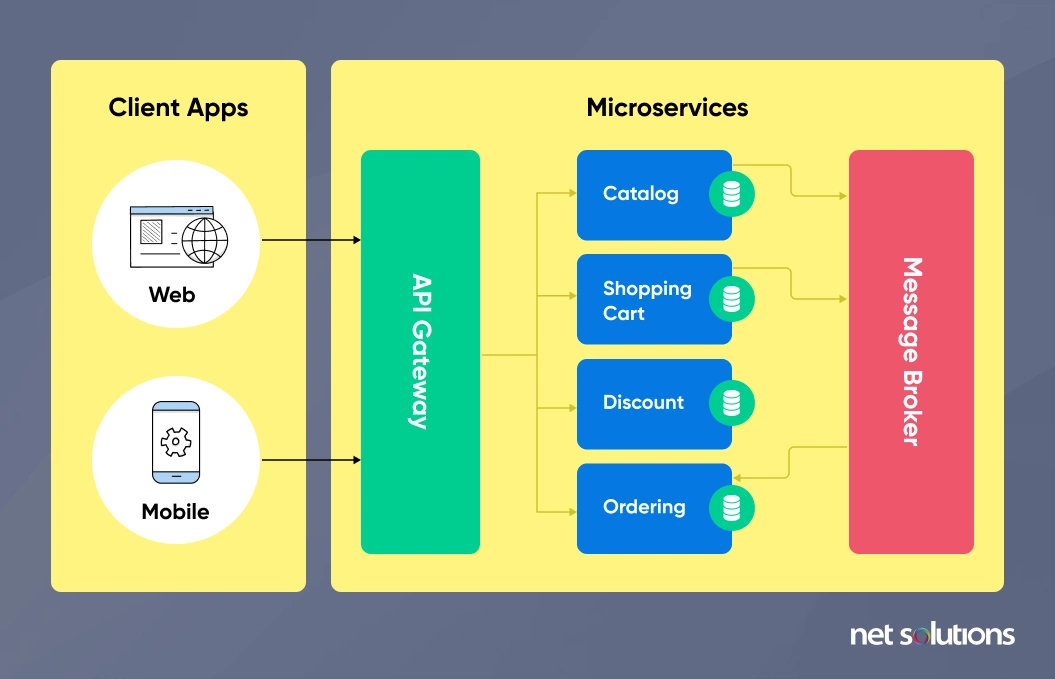
Who uses Microservices?
Microservices are widely used today by 85% of large organizations, over 5000 employees, and 75-84% of medium-sized organizations. Microservices have forever changed how applications are being developed and are now a critical part of other popular architecture models, including MACH Architecture (the “M” stands for Microservices).
Further, Microservices are an essential component of any approach to Application Modernization that help bring legacy apps up to modern standards. Microservices architecture is ideally suited for websites and applications that have many moving pieces that engage with customers, need to work across multiple channels, work with high volumes of data, or are subject to high volumes of traffic e:g eCommerce and financial services.
How does the Microservices Architecture work?
What is meant by microservices? To understand microservices architecture, one must first step back to understand icroservices vs. monolithic architecture.
Monolithic architecture is an approach to self-contained application development. This single-tier application includes the user interface, business logic (all the parts), and data interface to connect to the database. On the one hand, monolithic applications are simple to develop and test, but on the other hand, they become large, complex, and difficult to scale or change.
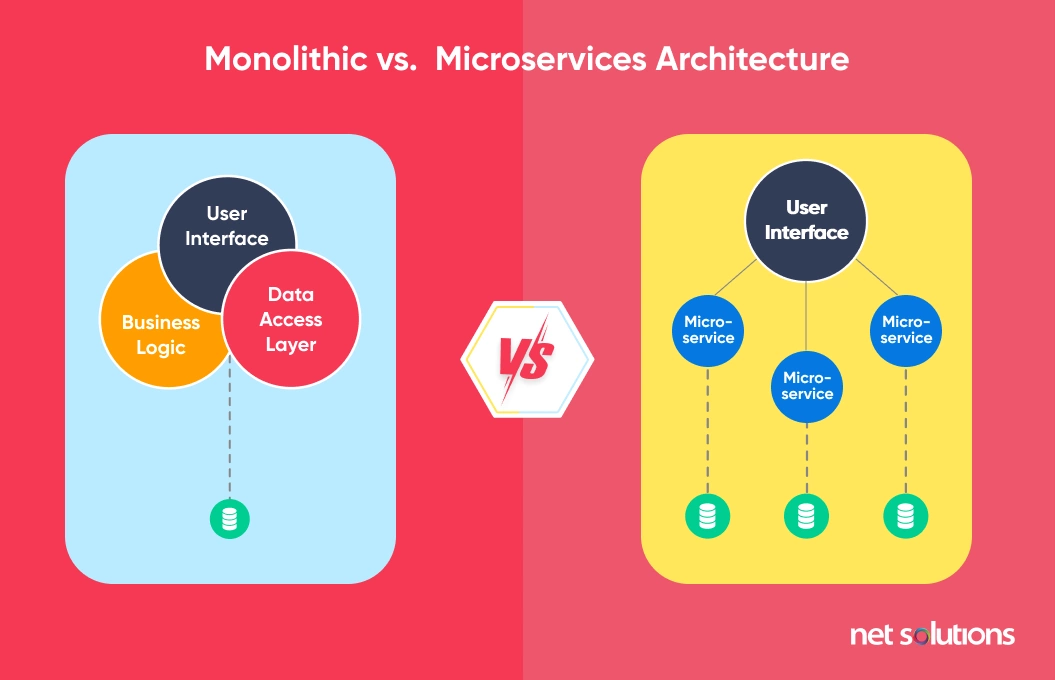
In contrast, microservices architecture uncouples the parts of the architecture, linking independent back-end services (microservices) together to the front via API. While some complexity is added to the architecture, microservices allow for the adaptation to new technologies, better scaling, and better performance.
For comparison, here is an eCommerce web application developed under monolithic and microservices architecture:
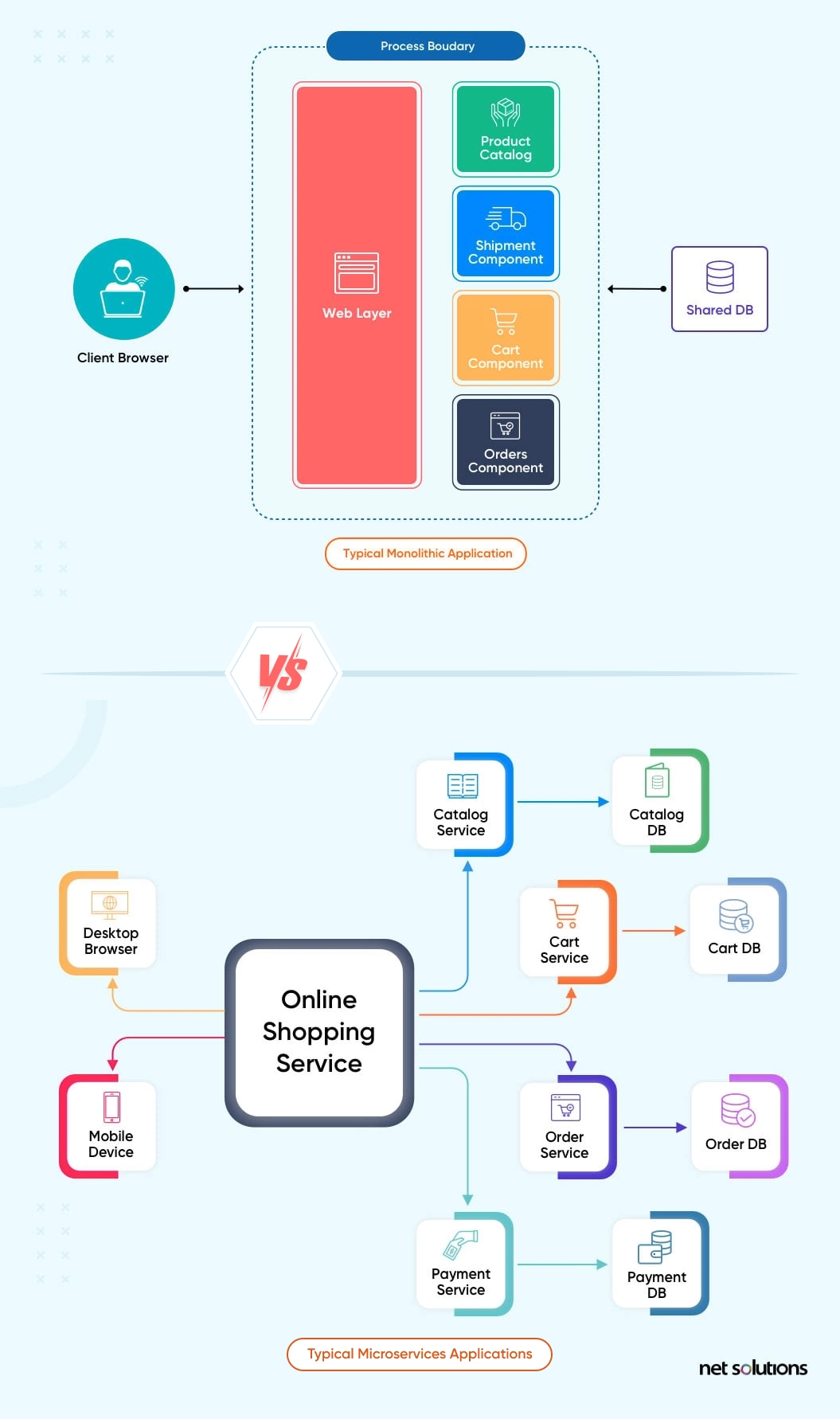
In a microservices architecture, each microservice component runs a critical process in the application but is independent of the rest, communicating with each other using HTTP/HTTPS requests and application programming interfaces (APIs). Microservices architecture is commonly a part of the following:
- Application modernization efforts – updating outdated, legacy applications by re-writing or porting (adapting) a legacy system to use more modern application languages and architecture such as microservices, libraries, and other technologies
- 12-factor app methodology – a set of twelve principles for building reliable and resilient software-as-a-service (SaaS) applications, including microservices
- MACH Architecture – a technology infrastructure that is based upon Microservices, API-first design, Cloud-native implementation, and Headless architecture that decouples the front and back end of the application.
- Cloud-native development – to build and ship applications designed for the cloud, leveraging the pillars of DevOps, continuous delivery, containers, and microservices
Examples of Microservices
What are microservices used for, in real examples? Some common microservices architecture use cases are for
- Amazon struggled with the growing size of its monolithic application, switching to microservices to allow for greater innovation in service and optimized performance.
- Netflix detailed its own journey to the cloud and microservices to reduce points of failure and scale individual features and services
- Spotify also chose microservices early on as a way to scale and allow for greater development agility of independent features.
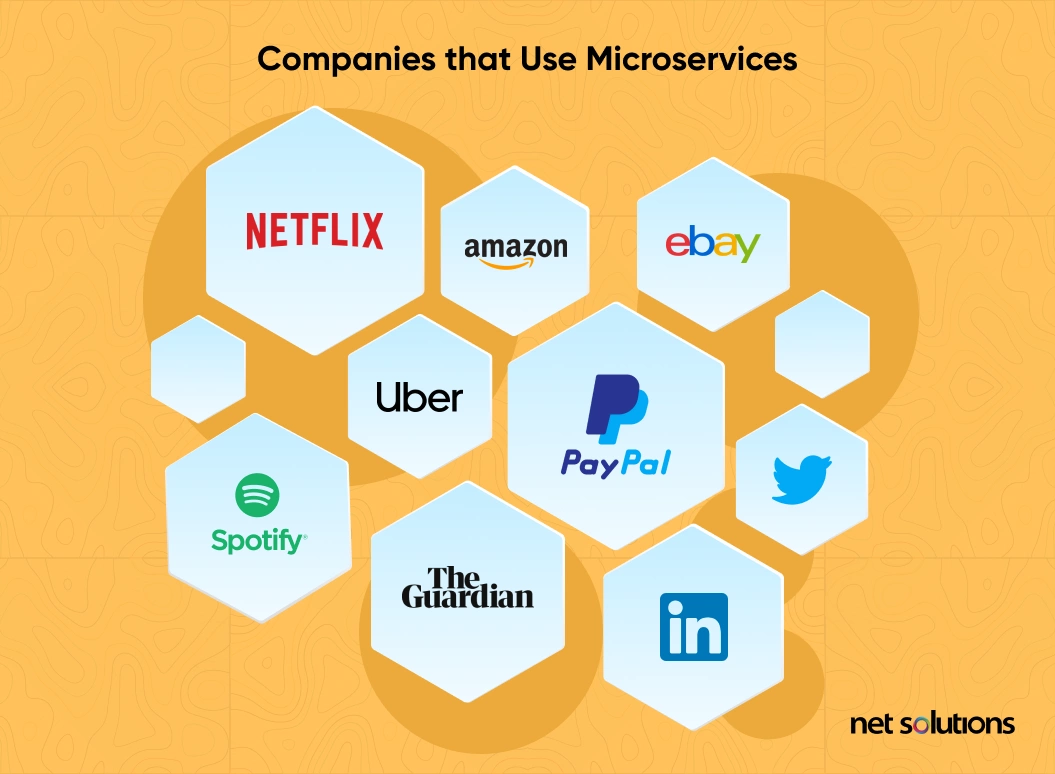
Characteristics of Microservices Architecture
Microservices architecture comprises
- Multiple Components: These are the microservices themselves, the self-contained services.
- API Gateway: A proxy to accept all API calls into the application.
- Containers: Each microservice is separated into its package or container, allowing services to work independently and be moved around. A container contains each component’s code, system tools, run time, libraries or dependencies.
- Service Mesh: A layer that provides additional security and predictable communication.
- Service Discovery: Helps manage deployment and support microservices to locate each other on the network.
- Business Capabilities: Each microservice must be owned by a team with end-to-end capabilities, so teams are based around services or capabilities rather than one piece of an application (e.g. UI or database).
- Simple Routing: Requests are processed without applying extensive business rules.
- Decentralized: Typically, each service has its own database and is managed independently.
- Failure Resistance: The failure of one service does not impact the other services.
- Evolution: Adjust to new technology or needs by only swapping or adding needed services.
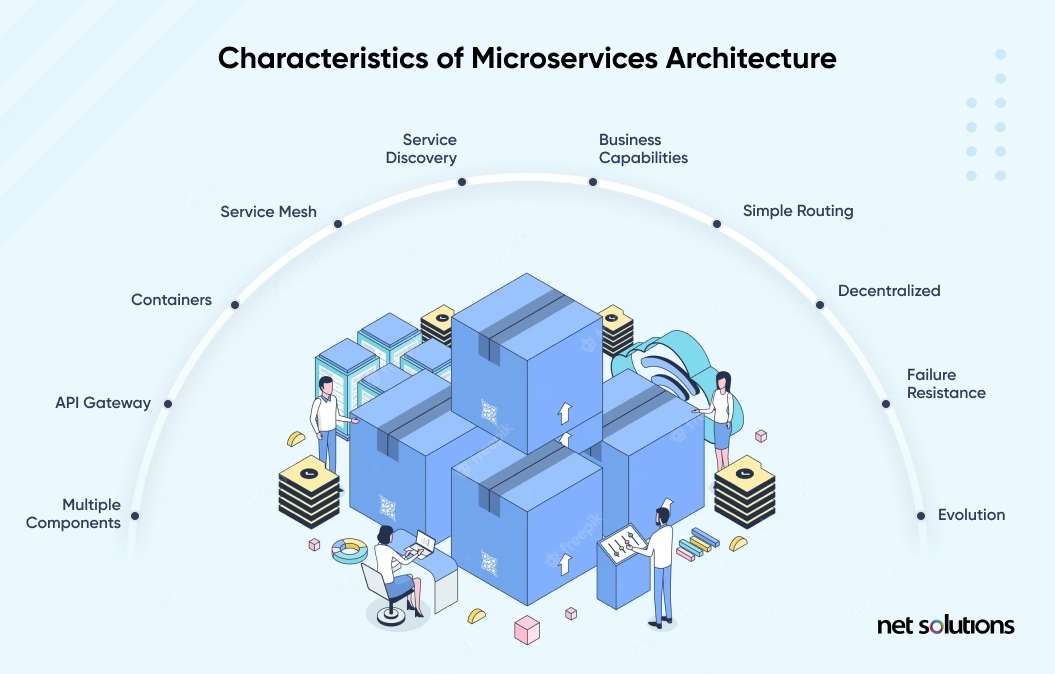
How do Microservices Benefit the Organization?
As noted in previous sections, microservices architecture is designed for flexibility and freedom, with the core benefits:
- Agility: Further, it is possible to update individual services, either in-house or with third-party services, to pivot as new technologies emerge or need change quickly.
- Flexible Scaling: Scalability is the primary benefit of microservices as each service can scale independently, helping ensure that services can scale when needed and that scaling remains cost-effective.
- Easy Deployment: Each microservice is developed, tested, and deployed independently, allowing for services to be deployed and updated without redeploying the entire application.
- Technological Freedom: Since developers are not stuck with one language or tech stack for the entire application, choosing a tech stack optimized for each function is possible.
- Resilience: Since each feature or service is independent of the others, a failure in one service does not render the entire application useless. This is important to maintain uptime, help isolate errors, and redeploy a fix as quickly as possible.
- Less effort to develop: Developers can work in parallel on different components.
Microservices Tools
Building a microservice architecture requires choosing a tech stack for each microservice, spanning the following areas:
- Operating System: A choice in OS to develop and execute program code. Linux, Ubuntu, Windows, MacOS
- Programming Languages: The ability to choose the programming language best suited to each service.
- Tools for API Management & Testing: Ensuring communication between microservices requires healthy APIs, which should be tested with tools such as Katalon, REST-assured, or Apigee.
- Tools for Messaging: Tools to connect microservices and help them communicate more effectively, such as RabbitMQ.
- Toolkit: Tools to help developers build microservices, often specialized to each language. For example, Seneca is a toolkit for Node.js.
- Architectural Frameworks: Frameworks assist developers in creating microservices and providing documentation and resources.
- Tools for Orchestration: Orchestration is the brain of microservices, the logic that understands how all the microservices fit together and what each does. Orchestration tools such as Kubernetes and Docker Swarm are popular options.
- Tools for Monitoring: Tools designed to monitor and troubleshoot the interdependencies between microservices. Some libraries handle monitoring, while others are strict monitoring platforms. Popular tools are Jaeger, Graphite, Datadog, and AWS CloudWatch.
- Serverless Tools: Serverless microservices can perform their function without needing a server, executing code in response to requests or other events.
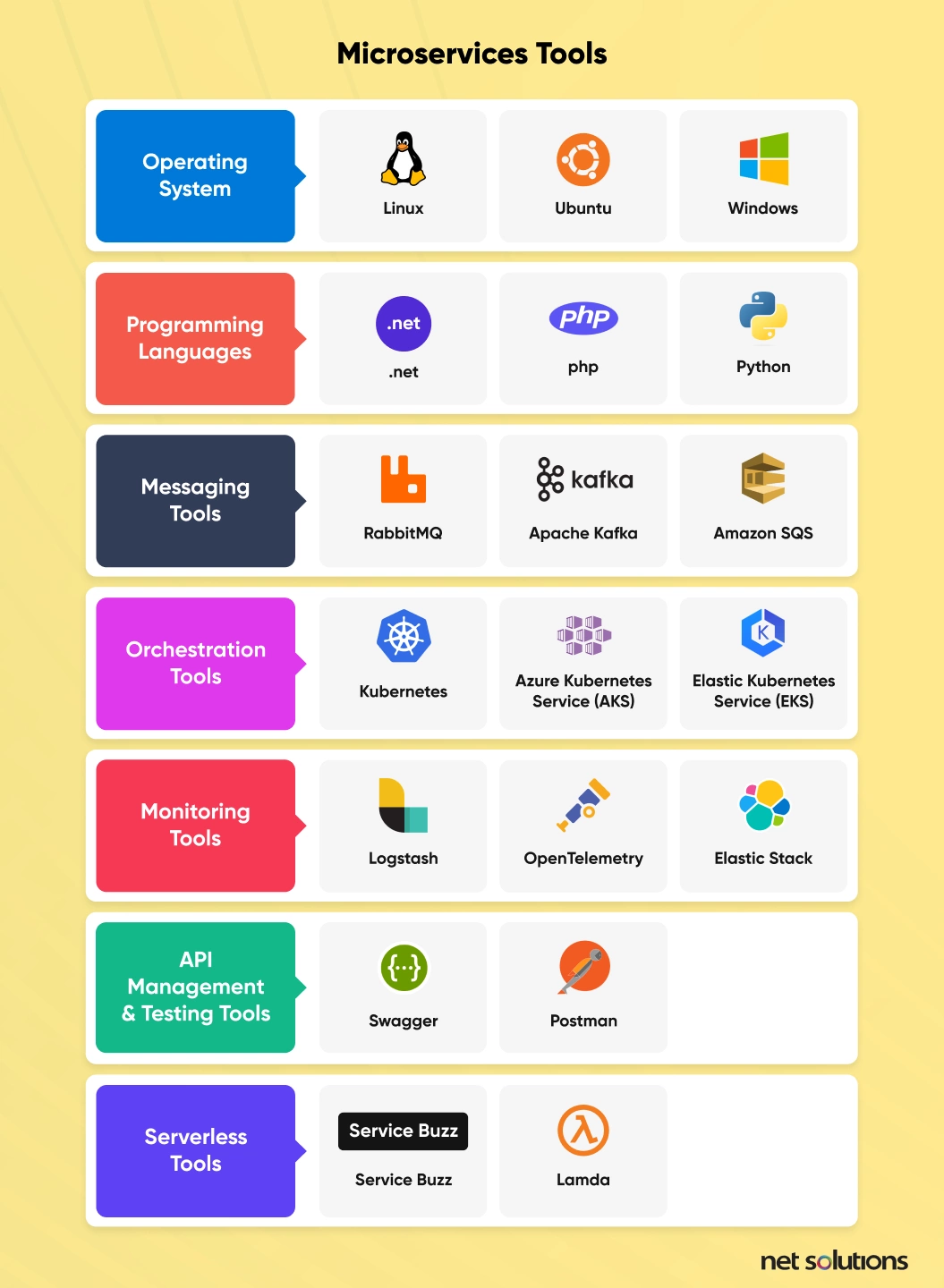
What are Microservices Design Patterns?
Microservices rely on architecture patterns, the most common of which are:
- Strangler pattern: An old system is hidden and eventually replaced as new services replace older services through refactoring.
- SAGA pattern: Supports transactions that span multiple services as a sequence of local transactions, each triggering the next transaction or triggering a failed alert that will undo previous changes.
- Aggregator pattern: Allows one service to collect requests and send requests to sub-services and, in return, act as a load balancer.
- Event Sourcing: Allows for sequential logging of events, rather than latest state event replacements, creating a historical event store that retains current data storage and reduces the risk of a transaction error.
- Command Query Responsibility Segregation (CQRS): Separates read and update operations for a database to reduce complex queries between microservices.
- Sidecar pattern: Deploys components into separate containers to provide isolation and encapsulation, allowing these to attach to a parent application.
- Database per Microservice: Each microservice has its database for greater data isolation and scalability.
- Backends for Frontends (BFF) pattern: Instead of one backend service for all client types (e.g., desktop, mobile), creates new backends for each client type to tailor each need.
- API Gateway pattern: A unified entry to a group of microservices, allowing microservices to communicate via the gateway instead of interacting directly.
- Circuit Breaker pattern: A pattern useful to reduce failure of operations by limiting the impact of singular service failures that can cascade other services’ attempts to call it – a way to build greater resiliency.
Challenges in Adopting Microservices
- Higher Complexity: Teams must be able to support greater technologies/tech stacks for each microservice, manage all the integrations, and meet higher needs for load balancing.
- Limited Reuse of Code: Since each service has its code, the only way to support code reuse is through external library creation – but that requires someone to manage the library.
- Increased Development Time: While teams can concurrently develop services, additional time must be spent to support dependencies.
- Dependency on DevOps: The creation of independent services places a higher burden on DevOps to support the continuous integration/continuous delivery (CI/CD) pipeline.
- Complicated in Global Testing and Debugging: Testing can be complex since the deployment is distributed across services.
Future of Microservices
The way developers use microservices continues to change as technology, frameworks, and design patterns evolve. We expect microservices to remain crucial to the cloud and the many advances, including serverless, new, and innovative AI integrations to support chatbots and data analysis. There are also some moves to improve microservices by embedding the service mesh into the public cloud platforms (read about the AWS app mesh). In the future, we could see:
- Multiple Microservices: Implying the integration layer that ties multiple microservices together. Applications could be built by connecting various APIs and services.
- Serverless Architecture: could be more in demand. We could have better tools for building ad deploying Microservices, with lesser need for a significant upfront investment.
- Function as a Service: meaning the decentralization of the complete application stack. The in-memory computer would be doing real-time analytics with intelligence-driven microservices.
- Multi-Cloud Environment: microservices could be used across multi-cloud environments, bringing advantages to their features
The future of Microservices will involve a steady & fast reduction in the friction for developers and operations. It would also empower them to build microservices from anywhere, with anyone.
Microservices Monitoring with Net Solutions
Net Solutions has over 20 years of experience in digital product development, helping organizations innovate, deploy, and iterate software that takes advantage of the latest and most popular technologies, including experience in microservices and containerization.
We have constantly been delivering applications based on the MS Architecture and have deployed MS applications on AWS, Google and Azure cloud providers. Net Solutions uses RabbitMQ as a message broker for asynchronous communication. Kong API gateway is yet another tool used for client projects.
Frequently Asked Questions
1.How are microservices deployed?
Microservices are deployed following one of several design patterns (see above) using a virtual machine or containers.
2.How do we scale microservices?
Microservices can scale horizontally (add more hosts of the service) and vertically (giving containers more resources / CPU power).
3.When to use microservices?
Microservices are ideally suited for applications that need to do a lot or are under a lot of pressure to scale. If you do not have a team, or an experienced partner, who can support a CI/CD pipeline with DevOps automation, is aware of technologies such as Docker and Containers, and has the capacity to manage the services and dependencies, likely, microservices is not ideal.
4.Microservices vs. API? And is a REST API a microservice?
Microservices is a design pattern that breaks applications into independent pieces – those pieces communicate via API. In this way, the API enables microservices but is not a microservice.
SHARE THIS POST
Table of Contents

